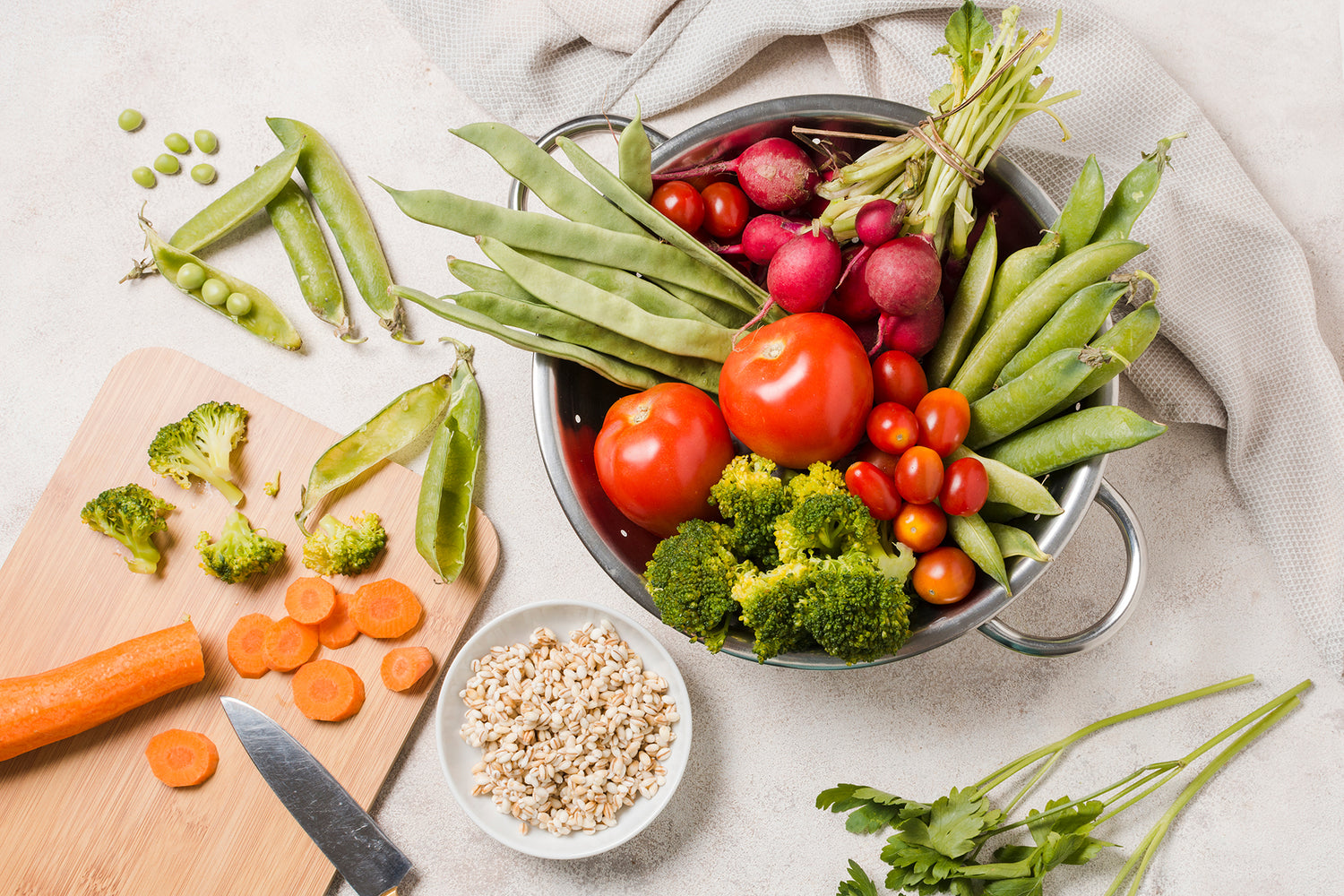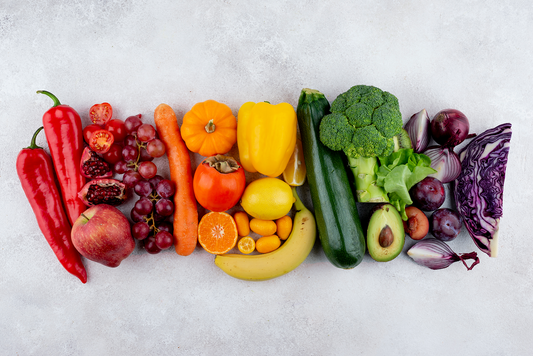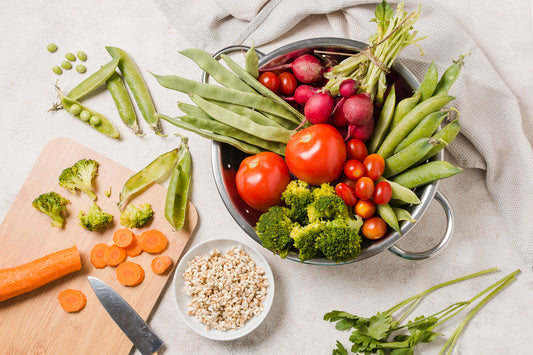It's widely acknowledged that a plant-rich diet is a treasure trove of essential vitamins and minerals that are vital for sustaining overall well-being and optimal bodily function. Yet, the true marvel lies in the hidden gems within fruits, vegetables, and other plant-based sources – the invaluable phytochemicals or phytonutrients. While these compounds may not be classified as essential for basic survival, they bestow extraordinary health benefits that deserve our attention.
Phytonutrients are not a single group of compounds but a diverse array of thousands of different substances, each with its unique properties and benefits. Examples include flavonoids, carotenoids, glucosinolates, and polyphenols.
These compounds are responsible for the vibrant colours, flavours, and aromas found in fruits, vegetables, grains, legumes, nuts, and seeds. While they aren't necessary for basic survival, they offer a wide range of health benefits that make them an essential component of a balanced diet.
Phytonutrients are important for several reasons. Firstly, they act as antioxidants, helping to neutralise harmful free radicals in the body. This antioxidant activity can potentially contribute to the maintenance of good health, not only through their antioxidant activity, but also as anti-inflammatory and anticarcinogenic agents[1][2].
Chronic inflammation is linked to many health problems, including arthritis and autoimmune diseases, so consuming a diet rich in phytonutrients can help reduce inflammation and promote better overall health.
The benefits of phytonutrients extend beyond just disease prevention. These compounds can also enhance our immune system, making us more resilient to infections. Furthermore, they support healthy digestion and gut health, which is increasingly recognised as a key factor in overall well-being.
There are naturally occurring phytonutrients in WE8THIS that are present from mains ingredients used such as oat, brown rice and multigrains. Some phytonutrients have also been added to WE8THIS because of their significant health benefits.
The following are the main phytonutrients present in WE8THIS:
Lutein
It is a powerful antioxidant that helps protect cells from damage caused by free radicals, which are harmful molecules in the body. Many people think of lutein as "the eye vitamin”. Lutein is one of two major carotenoids found in the human eye (macula and retina).
Lutein is known for its role in promoting eye health, specifically in reducing the risk of age-related macular degeneration (AMD)[3][4] and cataracts. It helps filter harmful high-energy blue light and acts as a natural sunblock for the eyes.
Lycopene
Like lutein, lycopene is a potent antioxidant, which means it helps protect cells from oxidative damage.
Lycopene has been linked to a reduced risk of certain types of cancer, particularly prostate cancer, and may also contribute to heart health by reducing the risk of heart disease[5][6] and decreases the risk of stroke in men[7].
It is also known for its potential benefits in promoting skin health and reducing the risk of sunburn when consumed regularly.
Zeaxanthin
It is closely related to lutein and is particularly concentrated in the macula of the eye.
Zeaxanthin, like lutein, plays a critical role in protecting the retina from oxidative damage and reducing the risk of AMD[8] and cataracts.
Both zeaxanthin and lutein are often recommended together for optimal eye health.
Beta-glucan
They are known for their ability to lower cholesterol levels and improve heart health. The primary source of beta-glucan is from oat. Oat beta-glucans have been shown to lower/reduce blood cholesterol[9], which in turn reduces the risk of developing coronary heart disease.
Beta-glucans also support the immune system by enhancing the activity of immune cells[9].
Additionally, beta-glucan can help regulate blood sugar levels and can contribute positively to long-term weight management[10].
Avenanthramide
Avenanthramides are a group of polyphenolic antioxidants primarily found in oat, one of the primary ingredients in WE8THIS™. Avenanthramides A, B, and C are the major constituents of the total soluble antioxidant phenolic compounds in oats.
Avenanthramides have been shown to possess antioxidant and anti-inflammatory properties that can help reduce the risk of chronic diseases[11], and may contribute to heart health by improving blood flow and reducing blood pressure.
References
- Rui Hai Liu. Health-Promoting Components of Fruits and Vegetables in the Diet. 2013 [Available from: https://www.ncbi.nlm.nih.gov/pmc/articles/PMC3650511/]
- Kris-Etherton P.M., Hecker K.D., Bonanome A., Coval S.M., Binkoski A.E., Hilpert K.F., Griel A.E., Etherton T.D. Bioactive compounds in foods: Their role in the prevention of cardiovascular disease and cancer. The American Journal of Medicine 2002 [Available from: https://www.amjmed.com/article/S0002-9343(01)00995-0/fulltext#%20]
- Stuart Richer O.D., Ph.D. a c, William Stiles M.D., J.D. a, Laisvyde Statkute M.D. a 1, Jose Pulido M.D. b, James Frankowski M.S., Ph.D. candidate a 2, David Rudy M.D., M.P.H. c, Kevin Pei B.S. c, Michael Tsipursky M.S. c, Jill Nyland R.N. a. Double-masked, placebo-controlled, randomized trial of lutein and antioxidant supplementation in the intervention of atrophic age-related macular degeneration: the Veterans LAST study (Lutein Antioxidant Supplementation Trial). Journal of the American Optometric Association
- Liwen Feng, Kailai Nie, Hui Jiang, Wei Fan. Effects of lutein supplementation in age-related macular degeneration. 2019 [Available from: https://www.ncbi.nlm.nih.gov/pmc/articles/PMC6936877/]
- Muhammad Imran, Fereshteh Ghorat, Iahtisham Ul-Haq, Habib Ur-Rehman, Farhan Aslam, Mojtaba Heydari, Mohammad Ali Shariati, Eleonora Okuskhanova, Zhanibek Yessimbekov, Muthu Thiruvengadam, Mohammad Hashem Hashempur, and Maksim Rebezov. Lycopene as a Natural Antioxidant Used to Prevent Human Health Disorders. 2020 [Available from: https://www.ncbi.nlm.nih.gov/pmc/articles/PMC7464847/]
- Joanna Fiedor and Květoslava Burda. Potential Role of Carotenoids as Antioxidants in Human Health and Disease. 2014 [Available from: https://www.ncbi.nlm.nih.gov/pmc/articles/PMC3942711/]
- Jouni Karppi, Jari A. Laukkanen, Juhani Sivenius, Kimmo Ronkainen, Sudhir Kurl. Serum lycopene decreases the risk of stroke in men. A population-based follow-up study. American Academy of Neurology . 2012 [Available from: https://n.neurology.org/content/79/15/1540]
- Stuart P. Richer O.D., Ph.D., William Stiles M.D., J.D.a, Kelly Graham-Hoffman PsyD, Marc Levin M.D., J.D., Dennis Ruskin O.D., James Wrobel DPM, Dong-Wouk Park, Carla Thomas. Randomized, double-blind, placebo-controlled study of zeaxanthin and visual function in patients with atrophic age-related macular degeneration: The Zeaxanthin and Visual Function Study (ZVF) FDA IND #78, 973. Journal of the American Optometric Association 2011.
- Emma J. Murphy,Emanuele Rezoagli, Ian Major, Neil J. Rowan, and John G. Laffey. β-Glucan Metabolic and Immunomodulatory Properties and Potential for Clinical Application. 2020 [Available from: https://www.ncbi.nlm.nih.gov/pmc/articles/PMC7770584/]
- El Khoury, C. Cuda, B. L. Luhovyy, and G. H. Anderson. Beta Glucan: Health Benefits in Obesity and Metabolic Syndrome. 2012 [Available from: https://www.ncbi.nlm.nih.gov/pmc/articles/PMC3236515/#B64]
-
Devendra Paudel, Bandana Dhungana, Melanie Caffe, and Padmanaban Krishnan. A Review of Health-Beneficial Properties of Oats. USDA National Institute of Food and Agriculture (Grant No. 2018-67017-27566). 2021 [Available from: https://www.ncbi.nlm.nih.gov/pmc/articles/PMC8625765/]







